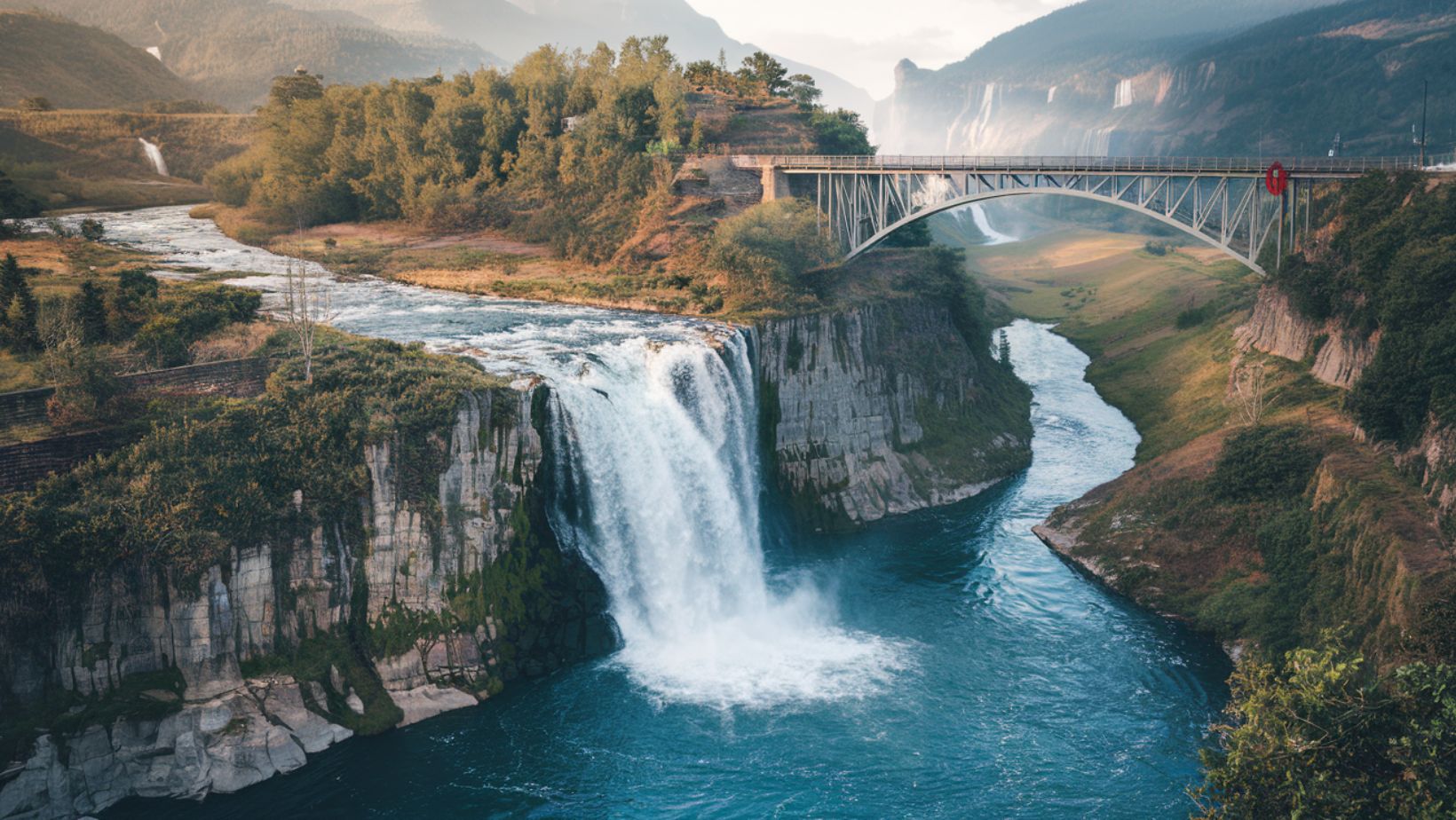What makes millions of visitors catch their breath at first sight of this majestic dual cascade? How did nature create such a perfect two-tiered masterpiece in the heart of the Columbia River Gorge? What ancient stories echo in the mist of Oregon’s tallest waterfall?
At Multnomah Falls, where engineering marvel meets raw natural power, a spectacle of water and stone continues to captivate visitors just as it has for centuries.
Multnomah Falls Stands as The Crown Jewel of Pacific Northwest Waterfalls
Rising 620 feet (189 meters) into the Oregon sky, Multnomah Falls represents nature’s grandest performance in the Columbia River Gorge. Like other significant waterfalls, it commands attention with its sheer scale, but what makes Multnomah truly unique is its distinctive double-drop formation. The upper falls plunges 542 feet before a brief pause at a natural platform, then continues another 69 feet to create the lower falls.
This natural phenomenon attracts over 2 million visitors annually, making it Oregon’s most visited natural recreation site.
The Historic Benson Bridge Creates Perfect Harmony Between Nature and Engineering
Spanning the gap between the upper and lower falls, the iconic Benson Bridge stands as a testament to human ingenuity. Built in 1914 by Italian stonemasons, this elegant concrete arch bridge provides visitors with an unparalleled viewpoint 105 feet above the lower cascade. Similar to how historic structures can enhance natural beauty, the bridge has become an inseparable part of the falls’ identity, creating countless photographic opportunities and allowing visitors to experience the raw power of the cascade from its midst.
Geological Forces Created This Natural Masterpiece Over Millennia
The formation of Multnomah Falls tells a story of volcanic activity and persistent erosion. Created by multiple lava flows from the nearby Cascade Range volcanoes, the cliff face reveals distinct layers of Columbia River basalt.
Underground springs fed by rain and snow melt provide the falls with year-round flow, making it one of the few Pacific Northwest waterfalls that never runs dry. Like Earth’s most impressive geological formations, the falls continue to evolve, with the water gradually carving deeper into the ancient basalt.
Native American Heritage Adds Deep Cultural Significance
According to Multnomah tribal legend, the falls were created to win the heart of a young princess who needed a private bathing place. This story, passed down through generations, is just one of many cultural connections that make the falls significant to indigenous peoples.
The area remains a sacred site for Native American tribes, who have maintained spiritual connections to these waters for thousands of years.
Seasonal Changes Transform the Falls Experience
Each season brings a different character to Multnomah Falls. Spring showcases maximum water flow as mountain snow melts, creating a thunderous display of natural power. Summer brings warm breezes that carry the falls’ mist to cool grateful visitors. Fall decorates the surrounding forest in brilliant colors, while winter often transforms the cascade into a partially frozen spectacle of ice and flowing water. These seasonal transformations make the falls worth visiting multiple times throughout the year.
Advanced Trail System Offers Multiple Viewing Experiences
A network of well-maintained trails provides various perspectives of the falls. The paved pathway to the lower viewing platform offers easy access for all visitors, while more adventurous hikers can climb to the upper viewing platform via a series of switchbacks. The challenging 6-mile loop trail to the top of the falls rewards hikers with panoramic views of the Columbia River Gorge and unique top-down perspectives of the cascade.
Conservation Efforts Protect This Natural Wonder
Ongoing conservation work ensures the falls’ preservation for future generations. The U.S. Forest Service manages visitor access while protecting the delicate ecosystem surrounding the falls. Recent initiatives focus on maintaining trail stability, preventing erosion, and protecting native plant species. Educational programs teach visitors about the falls’ geology, ecology, and cultural significance.
Modern Amenities Enable Year Round Visitation
The Multnomah Falls Lodge, built in 1925, provides visitors with comfortable facilities while maintaining historical authenticity. The lodge houses interpretive exhibits, a restaurant offering panoramic views, and a gift shop featuring local artisans’ work. Modern parking facilities and regular transit services from Portland make the falls accessible to visitors year-round, despite challenging weather conditions.
Photography Opportunities Attract Global Interest
Photographers from around the world come to capture Multnomah Falls’ ever-changing moods. The falls offer unique photographic challenges and opportunities throughout the day and year. Morning light creates rainbow effects in the mist, while evening light bathes the cascade in golden hues. Winter ice formations and autumn colors provide seasonal spectacles that draw professional and amateur photographers alike.
Environmental Challenges Shape Future Management
Climate change and increasing visitor numbers present ongoing management challenges. Conservation teams monitor water flow patterns, trail erosion, and ecosystem health while developing strategies to protect the falls’ natural character. Recent initiatives include improved visitor management systems and enhanced educational programs about environmental stewardship.
